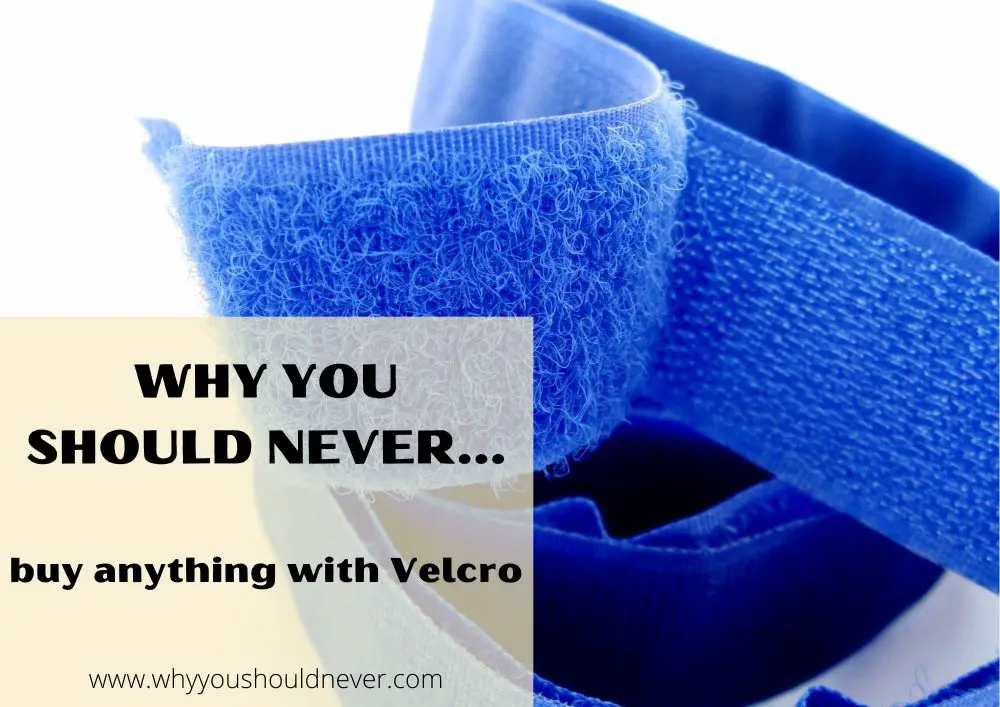![]()
Why You Should Never Buy Anything With Velcro
We all crave the simple life, and using a fastener that takes no time or effort at all would make our days just a little less stressful. Because, let’s face it, buttons and zippers can be troublesome.
So, on the surface, Velcro and other hook-and-loop fasteners might seem like a convenient way to fasten things. However, sometimes this type of fastening can be more trouble than it’s worth.
NEED TO KNOW
What is Velcro?
Velcro is the trademark name of a hook-and-loop fastener. It was invented in 1941 by Swiss engineer George de Mestral, who was inspired by how burdock burrs stuck to his dog’s fur after he went for a walk in the woods.
How do hook-and-loop fasteners work?
Hook and loop fasteners work by weaving the hooks (the rough side of the Velcro) into loops (the soft side). The hook catches in the loops, making it difficult to pull apart.
You’ll often see these popular contraptions used on things like footwear and bags.
This article will explore why you should stay away from anything that uses Velcro, and what you should opt for instead.
It’s loud
What is the Velcro sound?
According to this paper entitled Acoustics of tearing Velcro:
“Velcro sound is generated because of the vibration of the base on which the Velcro is attached. The vibration is induced by the snapping of the hooks and loops as the Velcro is pulled apart. Sound is radiated predominantly at the resonant frequencies of the base.”
Every time you unfasten it, there’s a huge, cracking/ripping sound that the whole world (or at least everyone in your house) will hear. It’s impossible for you to unfasten anything discreetly.
For this reason, some people may find the sound annoying and inconvenient.
It’s not strong enough to hold heavy things
Items like large, heavy backpacks will often come undone because the Velcro isn’t strong enough to keep them fastened. You’re left having to constantly hold them closed, which can be very frustrating!
It wears out and becomes less sticky
Velcro will last only as long as you keep it clean. Things like fluff and dirt will get stuck in the hooks over time, eventually leading the loop side of the contraption to stop sticking to it.
Velcro on clothing like shoes or a rain jacket won’t last as long because it’s constantly rubbing against things.
Once this happens, it will start unfastening very easily, and you’ll need to get it replaced. This could be detrimental if, say, your laptop bag uses Velcro and the straps come apart, sending your expensive device tumbling out.
It looks silly on adult clothing
Although Velcro wasn’t specifically designed with kids people in mind, due to its ease of use, you’ll often find it on children’s apparel – particularly shoes, as laces are more difficult to do up or tie for younger people.
Adult shoes also use Velcro, but because of the aforementioned simplicity, it has the effect of making adults look juvenile, as the fastening is associated with kids and other people unable to handle more complex fasteners.
It gets caught on things
One of the biggest pet peeves when it comes to hook-and-loop fastenings is when the hook side gets caught on unintended items.
If you’re not careful about how far apart the hook side is from the loop when pulling it open, you might find that the Velcro gets caught in clothing, hair, etc., potentially causing damage and pain.
Alternatives to Velcro and other hook-and-loop fasteners?
You can usually find items that use most other fasteners, so you never have to buy anything with Velcro if you don’t want to.
Laces (for shoes)
These are the standard. And although they do come undone, too, you can easily reinforce them by double-tying them, something you can’t do with Velcro.
Zips
Good, strong zips will keep most things fastened, and are easy enough to use. Zips are versatile and work well on bags, suitcases, jeans etc.
